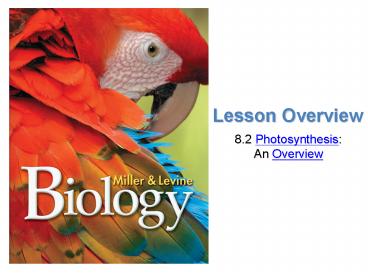Lesson Overview PowerPoint PPT Presentation
1 / 20
Title: Lesson Overview
1
Lesson Overview
- 8.2 Photosynthesis An Overview
2
Light
- Energy from the sun travels to Earth in the form
of light. - Sunlight is a mixture of different wavelengths,
many of which are visible to our eyes and make up
the visible spectrum.
3
Pigments
- Plants gather the suns energy with
light-absorbing molecules called pigments. - The plants principal pigment is chlorophyll.
4
Pigments
5
Chloroplasts
- Chloroplasts contain saclike photosynthetic
membranes called thylakoids, which are
interconnected and arranged in stacks known as
grana. - The fluid portion outside of the thylakoids is
known as the stroma.
6
Energy Collection
- When chlorophyll absorbs light, a large fraction
of the light energy is transferred to electrons.
These high-energy electrons make photosynthesis
work.
7
High-Energy Electrons
- The high-energy electrons produced by chlorophyll
are highly reactive and require a special
carrier. - Think of a high-energy electron as being similar
to a hot potato. If you wanted to move the potato
from one place to another, you would use an oven
mitt a carrierto transport it. - Plants use electron carriers to transport
high-energy electrons from chlorophyll to other
molecules.
8
High-Energy Electrons
- NADP (nicotinamide adenine dinucleotide
phosphate) is a carrier molecule. - NADP accepts and holds two high-energy
electrons, along with a hydrogen ion (H). In
this way, it is converted into NADPH. - The NADPH can then carry the high-energy
electrons to chemical reactions elsewhere in the
cell.
9
An Overview of Photosynthesis
- Photosynthesis uses the energy of sunlight to
convert water and carbon dioxide into high-energy
sugars and oxygen. - In symbols
- 6 CO2 6 H2O ? C6H12O6 6 O2
- In words
- Carbon dioxide Water ? Sugars Oxygen
10
An Overview of Photosynthesis
- Plants use the sugars generated by
photosynthesis to produce complex carbohydrates
such as starches, and to provide energy for the
synthesis of other compounds, including proteins
and lipids.
11
Light-Dependent Reactions
- Photosynthesis involves two sets of reactions.
- The first set of reactions is known as the
light-dependent reactions because they require
the direct involvement of light and
light-absorbing pigments.
12
Light-Dependent Reactions
- The light-dependent reactions use energy from
sunlight to produce ATP and NADPH. - These reactions take place within the thylakoid
membranes of the chloroplast. - Water is required as a source of electrons and
hydrogen ions. Oxygen is released as a byproduct.
13
Light-Independent Reactions
- During light-independent reactions, ATP and
NADPH molecules produced in the light-dependent
reactions are used to produce high-energy sugars
from carbon dioxide. - No light is required to power the
light-independent reactions. - The light-independent reactions take place
outside the thylakoids, in the stroma.
14
(No Transcript)
15
Questions
- In the process of photosynthesis, plants convert
the energy of sunlight into chemical energy
stored in the bonds of _________. - Carbohydrates
- Photosynthetic organisms capture energy from
sunlight with ________. - Pigment
- The plants principal pigment is _______.
- Chlorophyll
- Photosynthesis takes place in ___________.
- Chloroplasts
- T or F - Chloroplasts contain an abundance of
saclike photosynthetic membranes called
thylakoids. - TRUE
- T or F - The fluid portion of the chloroplast,
outside of the thylakoids, is known as the
matirx. - FALSE - STROMA
- Raising the energy levels of electrons on the
chlorophyll molecule, light energy can produce a
steady supply of _______________electrons, which
is what makes photosynthesis work. - High Energy
16
Questions
- 8. An electron _________is a compound that can
accept a pair of high-energy electrons and
transfer them, along with most of their energy,
to another molecule. - Carrier
- 9. NADP is converted to ______________as it
accepts and transfers electrons to chemical
reactions elsewhere in the cell. - NADPH
- 10. What is the overall equation of
photosynthesis? - 6CO2 6H2O light ? C6H12O6 6O2
- 11. The light- ______________reactions produce
ATP and NADPH from sunlight in the thylakoid
membranes. - Dependent
- 12. The light-______________t reaction in the
stroma, sugars are created from carbon dioxide
using the ATP and NAPH from the light-dependent
reactions. - Independent
17
Photosynthesis REVIEW
18
Photosynthesis REVIEW
19
Photosynthesis REVIEW
20
Journal
- What is the equation for photosynthesis?

